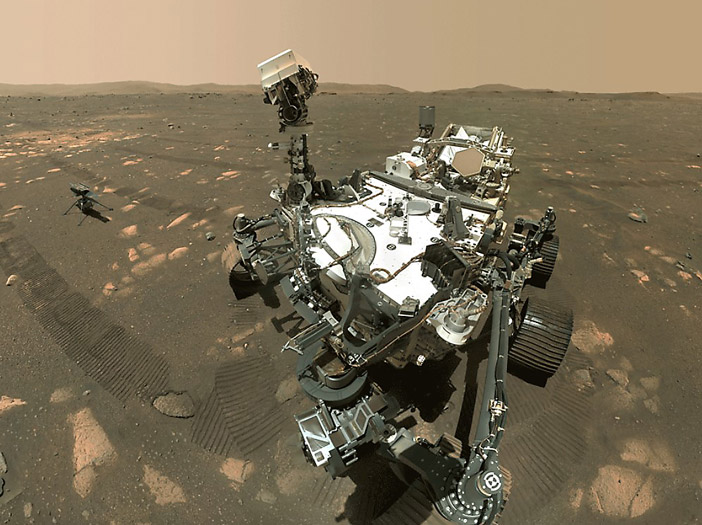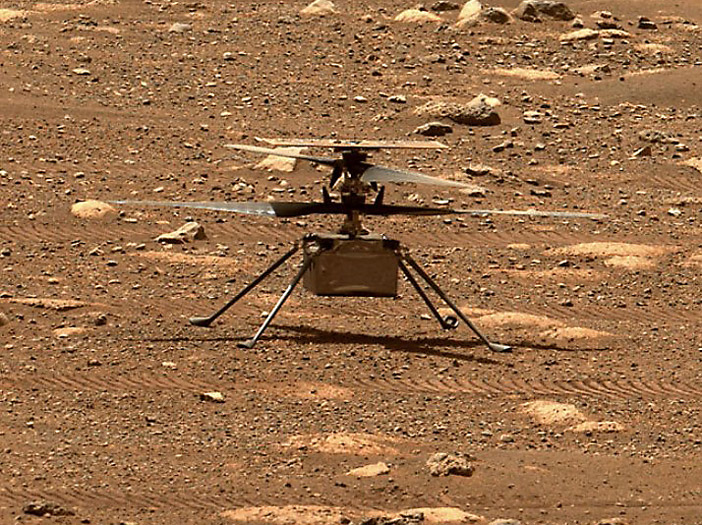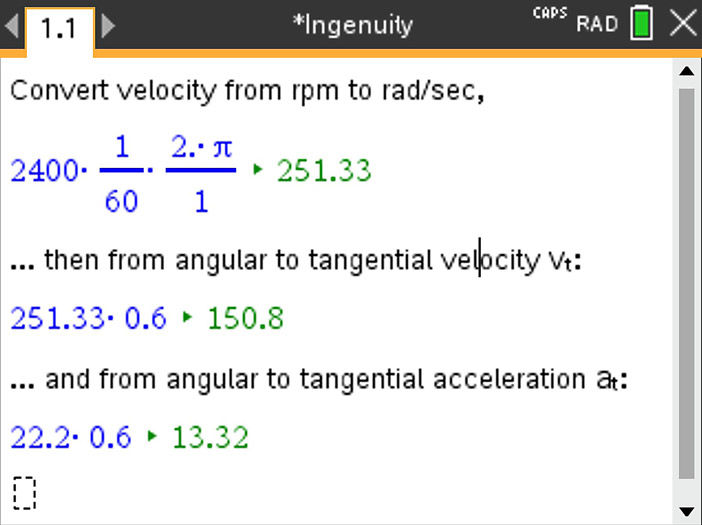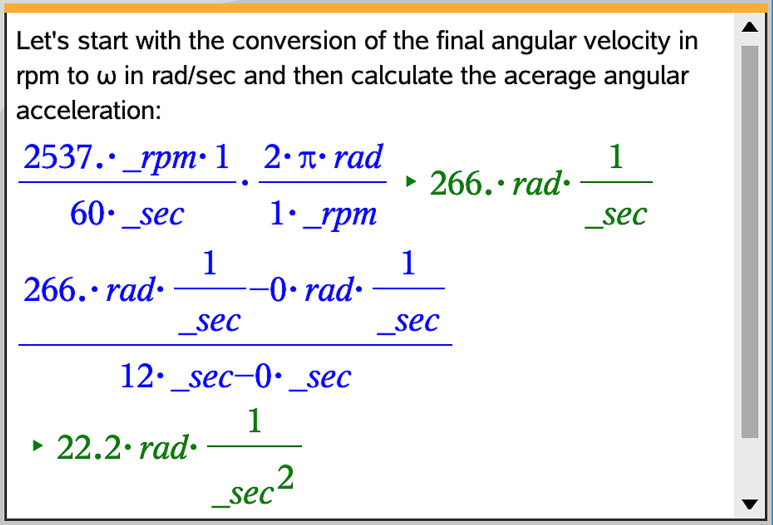From Wright Brothers to Ingenuity
Have you heard of the “The seven minutes of terror”? Sounds a bit like a horror movie, doesn’t it? And, actually for NASA, it is almost as nail biting!
Feb. 18, 2021, was an important date for NASA. After an almost seven-month journey, and a landing often called “The seven minutes of terror,” the Perseverance rover successfully landed on the surface of Mars. Perseverance carried an arsenal of scientific instruments designed to hunt for signs of past microbial life, if it ever existed. In other words, its mission is to hunt directly for these “biosignatures.” But Perseverance carried another important cargo. Stowed away safely on the underside of the rover was a small helicopter named Ingenuity, initially designed as a proof-of-concept for flight on another planet.
On Monday, April 19, 2021, Ingenuity took to the (thin) air for the first time. And, of course, any AP® Physics teacher looking to engage their students with a relevant and cool event would immediately look to come up with an activity using data about the helicopter. What an opportunity for a timely review of some AP® concepts, with three weeks left until the AP® exam.

Ingenuity’s key objectives are:
- Prove powered flight is possible in the thin atmosphere of Mars. While the planet has lower gravity (only about 1/3 that of Earth), its atmosphere is only about 1% as dense, making it much harder to generate lift. For comparison, that is about the same as Earth’s atmosphere at about 35 km altitude, which is about three times higher than commercial airliners fly.
- Operate autonomously. Once it has been placed on the surface by Perseverance, Ingenuity uses solar power to charge its batteries and rely on internal heaters to maintain operational temperatures during the cold Martian nights. Additionally, any flight plans will have to be uploaded in advance, since it takes anywhere from five to 20 minutes for a radio signal to travel the distance between Mars and Earth, depending on the planets’ positions.
Put on your seatbelt! There’s so much math and science to be explored here in the classroom. Let’s take a look at how this event served as an awesome springboard for some genuinely interesting explorations in the physics classroom.
Before we performed any calculations, we took some time to watch parts of a video that documents the planning and development of Ingenuity, “This Helicopter Just Flew on Mars!”
Another video that could be used as well is “How It Works - The Ingenuity Helicopter.”

After watching the video(s), the students were given the following information (found in this fact sheet from NASA):
- Height of Ingenuity: about 19 inches (0.49 meters)
- Weight of Ingenuity: 4 pounds (1.8 kg)
- Rotor system span: about 4 feet (1.2 meters)
- Counter-rotating blades spin to about 2,400 rpm
According to NASA, the spin-up of the rotor blades took about 12 seconds to go from 0 to 2,537 rpm, the optimal speed for the first flight. The ideas of angular velocity and angular acceleration are used to describe the motion of a rigid object like rotor blades rotating about a fixed axis.
Using the information provided above and what they had learned from the video, the students were asked to calculate:
- The angular velocity ⍵ of the blades in rad/s once they reach their final rpm
- The average angular acceleration α of the blades during the spin-up period
- The tangential velocity v of the blade tips once they have reached their final rpm
- And finally, to compare the tangential velocity of the blade tips to the speed of sound on Mars


We found that the velocity of 2,537 rpm, which the blades reached on that first flight, was equal to 266 rad/sec and that it took an average acceleration of about 22.2 rad/sec2 to reach that velocity. The question we asked next was: How fast are the tips moving in more familiar units, like ft/s or m/s? And why does that matter? The first step was rather straightforward from what they knew about the relationship between radial and tangential variables, v_t=r* ω .
In addition to a brief handout from the “Ingenuity Takes Flight” activity found on the Texas Instruments website, students were also provided with a TI-Nspire™ Document that included some simple directions for the calculations in a Notes app, where they just had to add some math boxes.
As an added challenge, students who had a TI-Nspire™ CX CAS graphing calculator performed their calculations using the correct units. That, more than the calculations themselves, turned out to be quite interesting.

Using the given radius of 0.6 m from the rotor shaft to the tip of the blades gave us a tangential velocity of almost 160 m/s (or 358 mi/hr). While that seemed like an incredibly high velocity for that tiny helicopter, students immediately suggested that, if generating the necessary lift in the very thin Martian atmosphere is such an issue, why not make the blades bigger and spin faster?
After we had a lively discussion about weight and size limitation, we kept coming back to the questions, “Why not make the blades spin faster? Would it be a problem if the tips go supersonic?” That brought up another good question, “Is the speed of sound on Mars the same as it is here on Earth?” Turns out it isn’t. Actually, because Mars’ atmosphere consists of 95% carbon dioxide (CO2) and has such low density and extreme temperature ranges, the speed of sound near the surface is about only 240 m/s. That means that at full speed, the tips of Ingenuity’s blades are already moving at about 2/3 the speed of sound. Which, as we found out, is more than the top speed for most helicopter designs. At this point, we also agreed that any further discussion would take us way too deep into the field of aeronautics and fluid dynamics.
While flying a helicopter on Mars is not one of the requirements to do well on the AP® Physics exam, the brief review of some of the concepts of angular kinematics using the very real data from Ingenuity was certainly worth the time spent. As an added bonus, it led to a very lively debate about the challenges faced by the team that worked so hard over the course of many years.
If you are looking for an additional challenge, H-M Hilbig has posted a great STEM activity, “Perseverance & Ingenuity – Control a Tello drone with TI-Innovator,” on the T³ Europe Resources website.
Note: At the time of this writing, Ingenuity’s key objectives have already been significantly expanded. A fifth successful flight was its first one-way journey from Wright Brothers Field to a new “airfield” about 130 meters to the south. This demonstration phase will focus on the capabilities a rotorcraft operating from Mars can provide, including scouting, aerial observations of areas not accessible by a rover, and detailed stereo imaging from atmospheric altitudes. Find more info here.
About the author: Karlheinz Haas (@karl0294) teaches AP® Physics, AP® Statistics and a STEM Lab class at The Pine School in Hobe Sound, Florida. Before coming to Florida, he taught science and mathematics in New Jersey and worked as an administrator in several school districts, in roles ranging from Math/Science Supervisor to Director of Curriculum and Assistant Superintendent. Haas is a National T³™ instructor, presenting regularly at Texas Instruments’ T³™ International Conference and at the annual NSTA STEM Forum and Expo. He sees the integration of technology as a great way to help students make connections between math and science.
Tagcloud
Archive
- 2025
- 2024
-
2023
- January (3)
- February (3)
- March (5)
- April (3)
- May (3)
- June (3)
- July (2)
-
August (6)
- 5 Ways to Spruce Up Your Classroom for Back to School
- Day of the Dog: Which Dog Is Roundest?
- Women Who Code: A TI Intern’s Fascinating STEM Journey
- 6 Sensational TI Resources to Jump-Start Your School Year
- 3 Back-to-School Math Activities to Reenergize Your Students
- A New School Year — A New You(Tube)!
- September (2)
- October (3)
- November (1)
- 2022
-
2021
- January (2)
- February (3)
- March (5)
-
April (7)
- Top Tips for Tackling the SAT® with the TI-84 Plus CE
- Monday Night Calculus With Steve Kokoska and Tom Dick
- Which TI Calculator for the SAT® and Why?
- Top Tips From a Math Teacher for Taking the Online AP® Exam
- Celebrate National Robotics Week With Supervised Teardowns
- How To Use the TI-84 Plus Family of Graphing Calculators To Succeed on the ACT®
- AP® Statistics: 6 Math Functions You Must Know for the TI-84 Plus
- May (1)
- June (3)
- July (2)
- August (5)
- September (2)
-
October (4)
- Transformation Graphing — the Families of Functions Modular Video Series to the Rescue!
- Top 3 Halloween-Themed Classroom Activities
- In Honor of National Chemistry Week, 5 “Organic” Ways to Incorporate TI Technology Into Chemistry Class
- 5 Spook-tacular Ways to Bring the Halloween “Spirits” Into Your Classroom
- November (4)
- December (1)
-
2020
- January (2)
- February (1)
- March (3)
- April (1)
- May (2)
- July (1)
- August (2)
- September (3)
-
October (7)
- Tips for Teachers in the time of COVID-19
- Top 10 Features of TI-84 Plus for Taking the ACT®
- TI Codes Contest Winners Revealed
- Best of Chemistry Activities for the Fall Semester
- Best of Biology Activities for the Fall Semester
- Best of Physics Activities for the Fall Semester
- Best of Middle Grades Science Activities
- November (1)
- December (2)
- 2019
-
2018
- January (1)
- February (5)
- March (4)
- April (5)
- May (4)
- June (4)
- July (4)
- August (4)
- September (5)
-
October (9)
- Art in Chemistry
- Which Texas Instruments (TI) Calculator for the ACT® and Why?
- Meet TI Teacher of the Month: Jessica Kohout
- Innovation in Biology
- Learning With Your Students
- A first-of-its-kind STEM strategy charts path to help educators
- #NCTMregionals Hartford 2018 Recap
- The Math Behind “Going Viral”
- Real-World Applications of Chemistry
-
November (8)
- Testing Tips: Using Calculators on Class Assessments
- Girls in STEM: A Personal Perspective
- 5 Teachers You Should Be Following on Instagram Right Now
- Meet TI Teacher of the Month: Katie England
- End-of-Marking Period Feedback Is a Two-Way Street
- #NCTMregionals Kansas City 2018 Recap
- Slope: It Shouldn’t Just Be a Formula
- Hit a high note exploring the math behind music
- December (5)
- 2017
- 2016
- 2015
